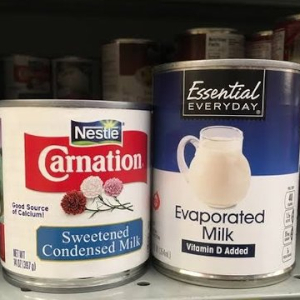Did you think condensed milk and evaporated milk were the same thing? Did you find out otherwise the hard way when you substituted one for the other in a delicate recipe? It’s time to set the story straight on condensed vs. evaporated milk…
 Evaporated Milk (left) and Condensed Milk (right).
Evaporated Milk (left) and Condensed Milk (right).
My Mom – bless her heart – set me straight about condensed vs. evaporated milk right at the outset, when I was first learning to cook. “Evaporated milk is like concentrated milk,” she explained. “Condensed milk is like concentrated cream.”
That’s maybe an oversimplified comparison, but it was enough to consolidate the difference between the two in my mind forever.
What IS the difference?
Evaporated milk is whole milk that’s had up to 60 percent of the water simmered out of it. Cooking also killed any bacteria. Evaporated milk tastes like regular milk, but it’s deemed chalky by some. It’s then sealed in cans, creating a shelf-stable product. Long shelf life was the main objective when evaporated milk was first developed. That was back in 1885, before refrigeration.
Evaporated milk is relatively low in fat and sugar, and very high in protein and essential vitamins and minerals.
Condensed milk is also simmered down by more than 60 percent and ‘fortified’ with a relatively large dose of sugar. It turns out syrupy consistency, very sweet (compared to the evaporated product) and much smoother in texture. And it has a distinct ‘ivory’ colour.
Used in similar applications
Both evaporated milk and condensed milk are used in baking. Condensed milk is favoured in many recipes because it not only brings the basic elements of milk, but also adds a creamy texture and bolsters the overall-sweet flavour profile of cakes, pastries and desserts. It contains ultra-concentrated fats and other nutrients. But it also delivers all that extra sugar.
Evaporated milk is often used to enrich soups and stews, and help texturize creamy casseroles and sauces. I’ve run into a number of cooks over the years who thought they could substitute regular whole or 2 percent milk for evaporated in Mac and Cheese or Scalloped Potatoes that called for milk but no flouer – and were disappointed when their dishes came out ‘watery’ or ‘curdled’.
Why not use condensed milk and make those dish even better? Because it’s decidedly sweet! And that doesn’t do anything good for a savoury dish. Not to mention that the sugar in condensed milk can caramelize during cooking and impart an unwanted brown colour plus an ‘off’ flavour to the dish.
My take
If a dish calls for evaporated milk, don’t substitute it with either whole milk or condensed milk. It just won’t work. Ditto, recipes calling for condensed milk. You’re just cruisn’ for disappointment if you use evaporated milk instead.
Sometimes, disaster may erupt from as simple a mistake as grabbing the wrong can off the pantry shelf. The labels are eerily similar.
There have been many menu innovations in the ‘white, creamy’ ingredient category over the years. Along with evaporated and condensed milk we now have mayo, sour cream, yogurt and cream cheese, along with silken tofu and other ‘exotic’ ingredients relatively new to western cuisine.
It behooves us all to get to know them, and use them properly!
~ Maggie J.

